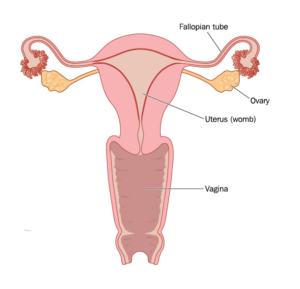The Uterus – A Complex Organ
Almost half of mankind owns this organ and every human life starts in it: the uterus. At the latest, with the first menstruation every woman becomes aware of her own uterus. But how exactly does the female reproductive organ look and what functions does it fulfil?
The uterus is one of the female internal reproductive organs. It consists of muscles whose shape resembles an inverted pear and is located slightly above the pubic bone. In an adult woman, the womb is 7-10 cm and weighs 50-60 g. It is supported by the pelvic floor muscles.
The uterus consists of two parts
The upper, thicker part of the uterus is called the body (Corpus Uteri), whilst the lower, narrower section forms the cervix (Cervix Uteri).
In the upper part of the uterine body, the fallopian tubes are located on both sides and transport the mature egg into the uterine cavity, where a fertilised egg may implant itself and develop into an embryo, in other words, a baby. However, this requires a well-built endometrium. Hormonal factors cause the endometrium to regenerate cyclically. If no pregnancy occurs, it is shed and menstruation occurs.
The connection between the uterus and the vagina is the cervix; while the cervical canal opens into the womb, the external orifice of the uterus leads to the vagina.
The uterus during pregnancy
When a baby is developing in the womb, the uterus does amazing things: it expands, stretches and thickens to accommodate the developing baby, the placenta and the amniotic fluid. The womb alone can weigh about one kilo during pregnancy. During birth, the muscles of the womb contract and different contractions eventually help to give birth to the baby.
Uterus diseases
If the pelvic floor is weak, the uterus may sag. Besides, benign tumours, so-called myomas, may form in the musculature of the uterus. A very common gynaecological disorder is endometriosis. The endometrium is mislocated outside the womb, which often is very painful for women and frequently leads to failure to conceive.
Uterine cancer affects the uterine body and is usually caused by hormones, but sometimes also by genetic predisposition. Unusual bleeding may be a symptom of cancer and should be checked.
For example, if a woman becomes infected with HPV (Human Papillomavirus) during sexual intercourse, in most cases, the HPV infection heals on its own. However, in rare cases, the infection persists and changes the tissue around the cervix. These changes (dysplasias) may also regress. However, precancerous stages up to and including cervical cancer may develop. For this reason, it is important to regularly visit the gynaecologist for a cancer screening, to detect cervical cancer early. If possible, in its preliminary stages.
——————————————
Cover Foto: GoodStudio/Shutterstock.com
Graphic: Blamb/Shutterstock.com

 GoodStudio/Shutterstock.com
GoodStudio/Shutterstock.com